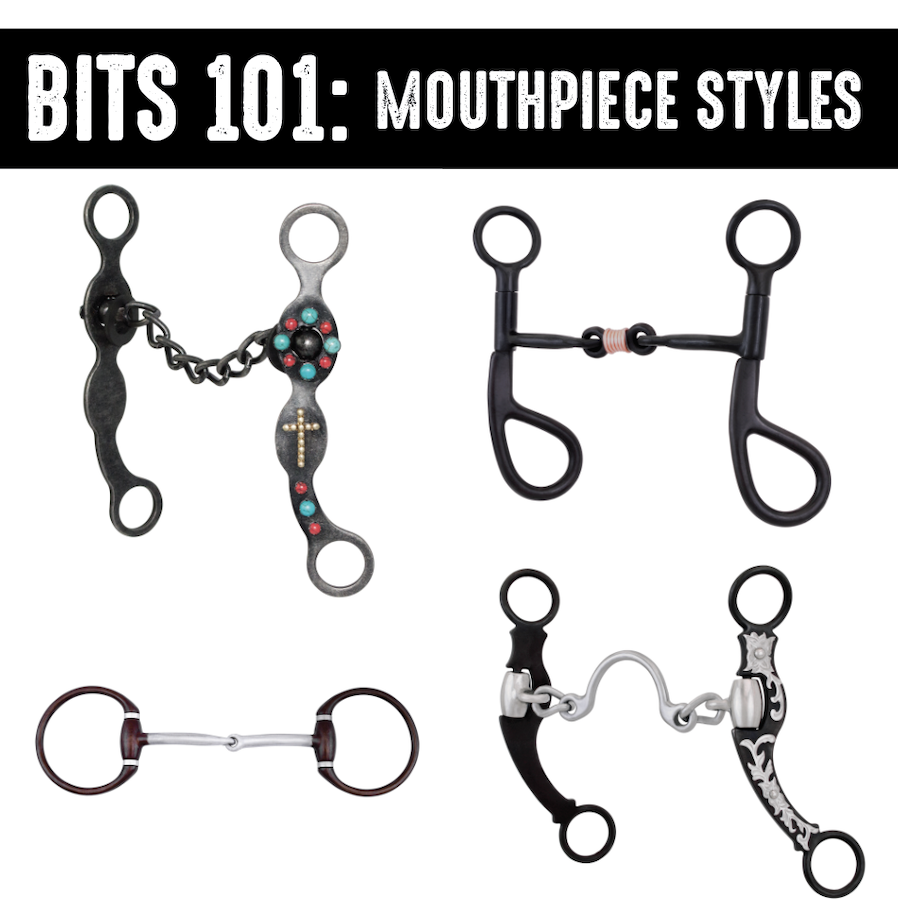
The most important thing to remember when it comes to selecting a bit is that every horse has different needs, and that not every type of bit will work for every horse. You may need to try a few options before finding the perfect fit.
When it comes to Western bits, there are two main categories – snaffle and curb. In general, a snaffle bit applies direct pressure to your horse’s mouth when the reins are pulled. With curb bits the pressure is indirect, but is stronger meaning less pull on the reins achieves greater pressure.
Both snaffle and curb bits can be jointed or non-jointed. Jointed mouthpieces feature a break – or joint – in the mouth piece to engage pressure on a horse’s mouth. There are many types of jointed mouth pieces, ranging from gentle to corrective.
We’ve outlined a few of the most common bit types and features below to help you decide which is best for your horse.
Non-jointed – Non-jointed bits have a straight, or slightly curved, solid mouthpiece. They are considered a very gentle bit, perfect for a young horse.
Single jointed – Single jointed bits are very common. The one joint in the middle allows the rider to apply pressure to one side of the mouth more than the other. The downside of the single jointed bit is that it can push down onto your horse’s tongue if both reins are pulled at the same time, creating a nutcracker effect on your horse’s mouth.
Double jointed – Double jointed bits have two joints and three sections. The middle section can be flat (sometimes called a French link or dog bone) or rounded (sometimes called a lozenge). A lozenge link mouthpiece will exert less pressure on the horse’s tongue when the reins are engaged. These are both comfortable styles for many horses as they reduce the nutcracker effect. However, some horses don’t like the extra tongue pressure that comes with the middle link.
Rollers – Some bits have rotating pieces called rollers on the mouthpiece. These are pieces that the horse can move with its tongue to encourage mouth play. It can help the horse be more relaxed in the mouth and jaw, and more accepting of the bit.
Ports – Ports have a raised “U” shape in the middle of the mouthpiece to reduce pressure on a horse’s tongue. This prevents the horse from softening the effect of the bit with its tongue. Ports can range from low to high.
Twisted – The twisted design of the mouthpiece applies concentrated pressure in the mouth. A slow twist, or one with fewer turns, is considered less severe than a fast twist with more turns. These are typically used on horses that have become unresponsive to other mouthpieces.
Chain – Chain bits have a chain of various thickness as the mouthpiece. The chain conforms to the curves of a horse’s tongue and put pressure on the corners of its mouth. They can be severe when used incorrectly.
While these are the most common bit styles, there are many more options out there. Whether you have a young, gentle horse or a strong willed, older horse, it’s important to keep in mind that the bit you select should be the least severe option that still gives you the communication and control you need. And always remember, a bit is only as harsh as the hands that hold it.
Stay tuned for the rest of our Bits 101 series, or check out the first part here.